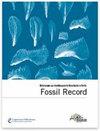下载PDF
{"title":"Palaeogeography and palaeoecology of early Floian (Early Ordovician) cephalopods from the Upper Fezouata Formation, Anti-Atlas, Morocco","authors":"Björn Kröger, Bertrand Lefebvre","doi":"10.1002/mmng.201200004","DOIUrl":null,"url":null,"abstract":"<p>In the central Anti-Atlas (Morocco), the Early Ordovician succession consists of about 1000 m of fossiliferous argillites and siltstones. The Upper Fezouata Formation (Floian) contains a comparatively rich and abundant cephalopod association. A small collection of these cephalopods is described herein for the first time. The cephalopods are interpreted as autochthonous or parautochthonous, representing a fauna, which originally lived nektobenthically in the open water above the sediments or related to the sea bottom. The cephalopod associations of the Upper Fezouata Formation are similar to other contemporaneous assemblages known from higher palaeolatitudes and associated with deeper depositional settings and in siliciclastically dominated deposits. They are composed almost exclusively of slender orthocones, in this case predominantly of <i>Destombesiceras zagorense</i> n. gen., n. sp., which is interpreted as an early discosorid. <i>Bathmoceras australe</i> Teichert, 1939 and <i>Bathmoceras taichoutense</i> n. sp. from the Upper Fezouata Formation are at present the earliest unambiguous occurrences of bathmocerid cephalopods. Epizoans on the shell of a specimen of <i>Rioceras</i> are the earliest evidence of bryozoans growing as potential hitchhikers on cephalopod shells, indicating an early exploitation of a pseudoplanktonic lifestyle in this phylum. (© 2012 WILEY-VCH Verlag GmbH & Co. KGaA, Weinheim)</p>","PeriodicalId":55147,"journal":{"name":"Fossil Record","volume":"15 2","pages":"61-75"},"PeriodicalIF":1.4000,"publicationDate":"2012-08-03","publicationTypes":"Journal Article","fieldsOfStudy":null,"isOpenAccess":false,"openAccessPdf":"https://sci-hub-pdf.com/10.1002/mmng.201200004","citationCount":"31","resultStr":null,"platform":"Semanticscholar","paperid":null,"PeriodicalName":"Fossil Record","FirstCategoryId":"89","ListUrlMain":"https://onlinelibrary.wiley.com/doi/10.1002/mmng.201200004","RegionNum":4,"RegionCategory":"地球科学","ArticlePicture":[],"TitleCN":null,"AbstractTextCN":null,"PMCID":null,"EPubDate":"","PubModel":"","JCR":"Q3","JCRName":"Earth and Planetary Sciences","Score":null,"Total":0}
引用次数: 31
引用
批量引用
Abstract
In the central Anti-Atlas (Morocco), the Early Ordovician succession consists of about 1000 m of fossiliferous argillites and siltstones. The Upper Fezouata Formation (Floian) contains a comparatively rich and abundant cephalopod association. A small collection of these cephalopods is described herein for the first time. The cephalopods are interpreted as autochthonous or parautochthonous, representing a fauna, which originally lived nektobenthically in the open water above the sediments or related to the sea bottom. The cephalopod associations of the Upper Fezouata Formation are similar to other contemporaneous assemblages known from higher palaeolatitudes and associated with deeper depositional settings and in siliciclastically dominated deposits. They are composed almost exclusively of slender orthocones, in this case predominantly of Destombesiceras zagorense n. gen., n. sp., which is interpreted as an early discosorid. Bathmoceras australe Teichert, 1939 and Bathmoceras taichoutense n. sp. from the Upper Fezouata Formation are at present the earliest unambiguous occurrences of bathmocerid cephalopods. Epizoans on the shell of a specimen of Rioceras are the earliest evidence of bryozoans growing as potential hitchhikers on cephalopod shells, indicating an early exploitation of a pseudoplanktonic lifestyle in this phylum. (© 2012 WILEY-VCH Verlag GmbH & Co. KGaA, Weinheim)
摩洛哥Anti-Atlas上Fezouata组早弗洛世(早奥陶世)头足类动物的古地理和古生态学
在反阿特拉斯中部(摩洛哥),早奥陶世的演替由约1000 m的泥岩和粉砂岩组成。上部Fezouata组(弗洛ian)具有相对丰富的头足类组合。本文首次描述了这些头足类动物的一小部分。头足类动物被解释为原生或准原生,代表了一种动物群,它们最初生活在沉积物上方的开阔水域或与海底有关。上Fezouata组的头足类组合与其他高古纬度已知的同时期组合相似,与较深的沉积环境和硅质沉积层有关。它们几乎完全由细长的正锥体组成,在这种情况下主要是Destombesiceras zagorense n. gen., n. sp.,这被解释为早期的dissorid。来自Fezouata上组的Bathmoceras australe Teichert, 1939和Bathmoceras taichoutense n. sp是目前最早的明确出现的Bathmoceras头足类动物。裂谷螈标本壳上的表皮虫是苔藓虫在头足类动物壳上作为潜在的搭便车者生长的最早证据,表明这门动物早期利用了一种假浮游生活方式。(©2012 WILEY-VCH Verlag GmbH &KGaA公司,Weinheim)
本文章由计算机程序翻译,如有差异,请以英文原文为准。


